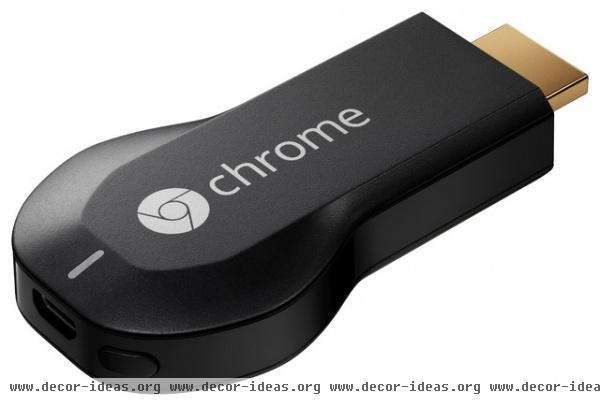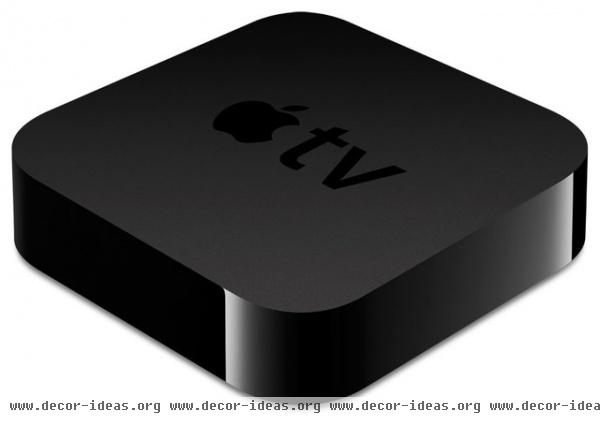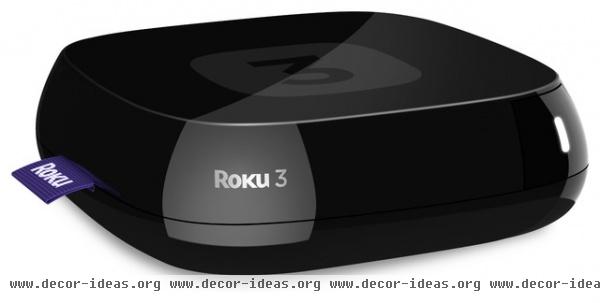Now Playing in Homes Everywhere: TV, the App
In the 1950s a TV set was the highest high tech in the home — and the only means by which families could watch any kind of professionally produced audiovisual content in the home. Now you can watch such content on a TV, PC, laptop, tablet or phone, or on a device built into the inside of a car. And the content streaming on these devices can now be viewed on any other device — including the TV.
Nowadays TV comes through every pipe and plays on every screen, thanks to the Internet. This model of getting TV shows, and things that are like TV shows, over the Internet instead of through cable TV companies is gaining ground quickly and threatening traditional business models for TV content creators.
In fact, one Silicon Valley giant recently surprised everyone with a new way to cut the cable.

Chromecast - $35 » Google recently announced a new product called Chromecast, which doesn’t look like much, doesn’t cost too much and doesn’t take up much space in the already-crowded lineup of stuff connected to your TV.
In fact, Chromecast looks like one of those cheap USB thumb drives for storing files. But it’s not USB. It plugs into your TV’s HDMI port. And it’s not a thumb drive, but a streaming video “box” like the Apple TV or Roku 3.
The most important fact about Chromecast is that it’s cheap. It costs about $35. This price point is inspiring fans to buy one for every TV in the house. The second fact is that it’s simple to use. Plug it into your TV and press a button, and it works. The third fact is that it runs from Google’s Chrome browser on any phone, tablet, laptop or desktop PC. When the Chromecast dongle and the device with the Chrome browser are both on the same home Wi-Fi network, they connect with each other. Once they're connected, the content of any tab in the running browser can be sent off to the TV.
For example, you can bring up in that tab Netflix, YouTube, Hulu or any number of current and future apps or services created for the Chromecast device. Once the content is sent, Chromecast switches over to the HD version of it. Chromecast also shows pictures or ordinary websites on your TV as well.
Best of all, you can continue to use the device for other things, including for content associated with the TV show or movie on the TV screen.
Think about what Chromecast enables. Any device in the house can send just about anything onscreen to any TV with the press of a button. Chromecast doesn’t necessarily do more than the alternatives. But it does what it does more cheaply, easily and universally.

Apple TV - $99 » If you’re an iPhone, iPad or Mac user, an alternative to Chromecast is Apple TV, which does more but isn’t quite as inexpensive or easy to set up. Apple TV is great at playing whatever’s on your Apple device or whatever you can find on iTunes.
Apple TV provides channels that Chromecast does not, including HBO Go, WatchESPN and MLB.TV, and includes most of the content sources that Chromecast does provide, including Hulu, Netflix and YouTube. Unlike Chromecast, Apple TV comes with a tiny remote control. You can, however, take content from an Apple-made phone, tablet, laptop or desktop computer and throw it over to the screen by tapping on a button.
Another point to consider is the past and the future. If you’re heavily invested in iTunes content, Apple TV may make a lot of sense, because you won’t be able to watch those shows or movies on an alternative device. Apple is expected to aggressively expand its offerings in the TV arena in the future, so if you’re a fan of Apple products and believe the company will deliver great services and products in the future, Apple TV may be a good choice.

Roku 3 - $99 » A Roku 3 box is similar to Apple TV, grabbing content from the Internet through your home’s Wi-Fi or Ethernet connections. It also offers a comparable lineup of content sources, including Netflix, Hulu Plus, Amazon Instant Video, Crackle, Vudu, HBO Go and hundreds more. One of the main types of content that Roku offers that Chromecast and Apple TV do not is Amazon-based movies and TV shows.
As with Apple TV, you can mirror content from iOS or Android devices. You control a Roku device with an included remote control, which even has a headphone jack for watching TV without disturbing others.
More Options for Watching Content
Chromecast, Apple TV and Roku 3 are the top options for combining some cable content with most Internet content for a great home entertainment experience. But you should know five things before you choose one of them.
There are dozens of other options that offer comparable functionality. You don’t need any of them. A simple laptop with HDMI-out capability connected to a TV will give you everything that can be streamed or downloaded from the Internet. None of these options gives you all cable shows when they air. In fact, some of the best and most popular shows currently in production, such as AMC’s Mad Men, can’t be viewed live via these options — you can see them live only with the associated cable subscription. In the best case, you may have to wait a day.Although Roku and other products let you subscribe to live TV events, such as sports games, these are subject to local blackouts — for example, when the area team is playing in town. Live HD network programming is still available — are you sitting down? — with an antenna. (You can see what’s available in your area on this site.)All the options mean you can find a device and setup with the level of convenience and flexibility that suits you best. It’s a great time to be a couch potato.
More: Check out the emerging virtual-reality home systems












